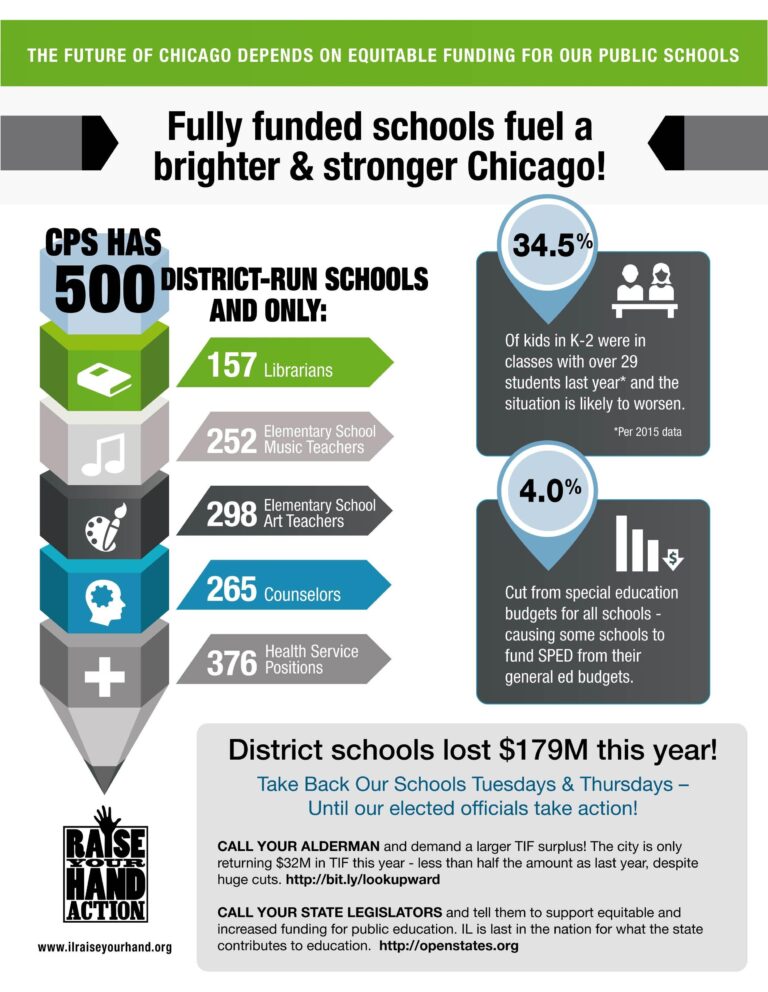Chicago Public Schools Confronts a $1.6 Billion Funding Deficit Jeopardizing Educational Excellence
Chicago Public Schools (CPS), one of the largest urban school districts in the United States, is currently facing a substantial financial shortfall estimated at $1.6 billion. This deficit threatens the district’s capacity to provide a high-quality education and maintain essential programs for its diverse student body. Recent fiscal reports highlight the urgent need for increased state funding to prevent important cutbacks that could disproportionately affect underfunded schools and vulnerable student populations.
Funding Crisis Undermines Educational Equity and Program Sustainability
The $1.6 billion gap in CPS’s budget poses a serious risk to the district’s ability to uphold educational standards and sustain critical services. Without this infusion of funds, schools may be forced to reduce classroom resources, limit teacher hiring, and curtail programs that contribute to student growth beyond academics. This shortfall is likely to exacerbate existing inequalities, particularly in neighborhoods where schools already struggle with limited resources.
Areas most vulnerable to budget cuts include:
- Special education services: These require specialized staff and adaptive learning tools, which are costly but essential for students with disabilities.
- After-school and extracurricular programs: Vital for fostering social skills, creativity, and physical health.
- Building upkeep and safety: Maintaining secure, clean, and modern facilities is crucial for effective learning environments.
- Technology enhancements: Upgrading digital infrastructure to support hybrid and remote learning models remains a priority post-pandemic.
Without prompt legislative intervention, CPS warns that these cutbacks could lead to larger class sizes, fewer support staff, and diminished enrichment opportunities, all of which undermine student success and well-being.
State Funding Deficiencies Impede CPS’s Capacity to Serve Students Effectively
The persistent underfunding from the state restricts CPS’s ability to meet the complex needs of its student population, which includes a significant number of English language learners and students requiring special education. The district’s financial constraints hinder expansion of critical services such as targeted tutoring,mental health counseling,and advanced coursework,all of which contribute to improved academic outcomes and college readiness.
Operational challenges stemming from budget shortfalls include:
- Teacher compensation stagnation: Competitive salaries are essential to attract and retain qualified educators, yet funding limitations have led to wage freezes and increased turnover.
- Deferred infrastructure improvements: Aging facilities with delayed repairs compromise safety and student attendance.
- Restricted access to advanced placement and STEM programs: Limiting opportunities for students to engage in rigorous coursework affects long-term academic achievement.
| Funding Shortfall | District Impact | Effect on Students |
|---|---|---|
| $1.6 billion | Program expansion halted | Fewer enrichment and support services |
| $200 million | Teacher pay freezes | Increased educator turnover |
| $150 million | Facility maintenance delays | Higher absenteeism and safety concerns |
Thorough Financial Breakdown Highlights Critical Investment Needs
A detailed fiscal review of CPS’s budget reveals that the $1.6 billion funding gap spans multiple essential categories, each vital to delivering a well-rounded education.The analysis underscores the necessity of boosting investments in teacher salaries, instructional materials, infrastructure, and student support services to meet both current demands and future challenges.
Key budgetary areas requiring increased funding include:
- Educator compensation: Enhancing wages to retain experienced teachers and attract new talent amid competitive labor markets.
- Learning resources: Updating textbooks, digital platforms, and science labs to align with modern educational standards.
- Facility improvements: Addressing ventilation, sanitation, and safety code compliance to create healthy learning spaces.
- Student-centered services: Expanding counseling, special education, and extracurricular offerings to support holistic development.
| Category | Current Budget (in millions) | Additional Funding Needed (in millions) |
|---|---|---|
| Teacher Salaries | 650 | 500 |
| Instructional Materials | 300 | 400 |
| Facility Maintenance | 200 | 350 |
| Student Support Services | 250 | 350 |
| Total | 1,400 | 1,600 |
Strategic Policy Solutions for Long-Term Financial Stability and Equity
Addressing CPS’s funding crisis requires more than temporary fixes; experts advocate for lasting financial frameworks that ensure consistent and equitable funding over time. Prioritizing investments based on student needs, especially in historically underserved communities, is essential to closing achievement gaps and fostering inclusive educational environments.
Legislative measures play a pivotal role in securing this future. Policymakers are encouraged to enact laws that establish guaranteed minimum funding levels for public schools statewide, enabling districts like CPS to plan effectively and allocate resources strategically.
- Implement transparent reporting systems detailing educational expenditures and outcomes to enhance accountability.
- Encourage public-private partnerships aimed at improving school infrastructure and technology access.
- Develop monitoring mechanisms to ensure funds are directed toward programs that yield measurable improvements in student achievement.
| Policy Advice | Goal | Anticipated Outcome |
|---|---|---|
| Stable Funding Guarantees | Provide predictable annual budgets | Enhanced resource planning and program continuity |
| Equity-Focused Resource Distribution | Direct funds to high-need student populations | Reduction in educational disparities |
| Openness and Accountability Initiatives | Increase public oversight of spending | Greater trust and improved outcomes |
Looking Ahead: The Imperative for Action to Secure Chicago’s Educational Future
As Chicago Public Schools confronts this significant budgetary challenge, the necessity for an additional $1.6 billion in state funding becomes increasingly clear. The district’s financial health directly influences the quality of education accessible to thousands of students, many of whom come from marginalized communities. With Illinois lawmakers poised to debate education funding in the near future, the decisions made will have lasting implications on equity, student achievement, and the overall vitality of Chicago’s public education system.
Ensuring that every child in Chicago has access to a safe, well-resourced, and supportive learning environment demands urgent and sustained commitment from state leaders, educators, and community stakeholders alike.





